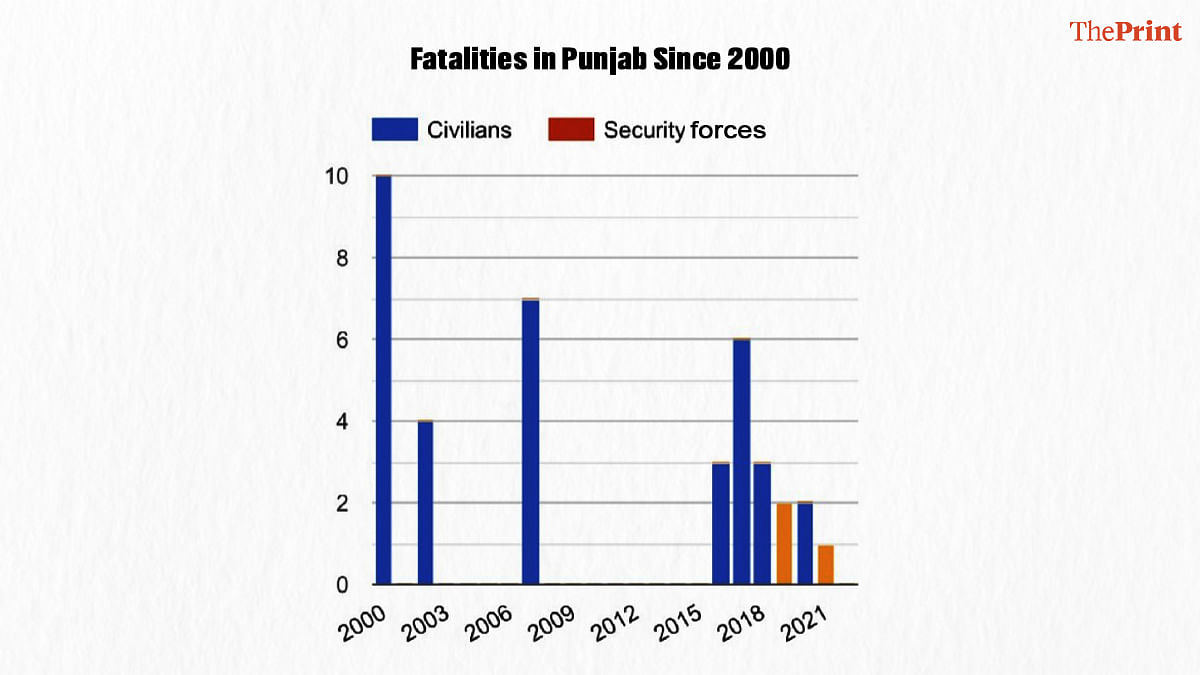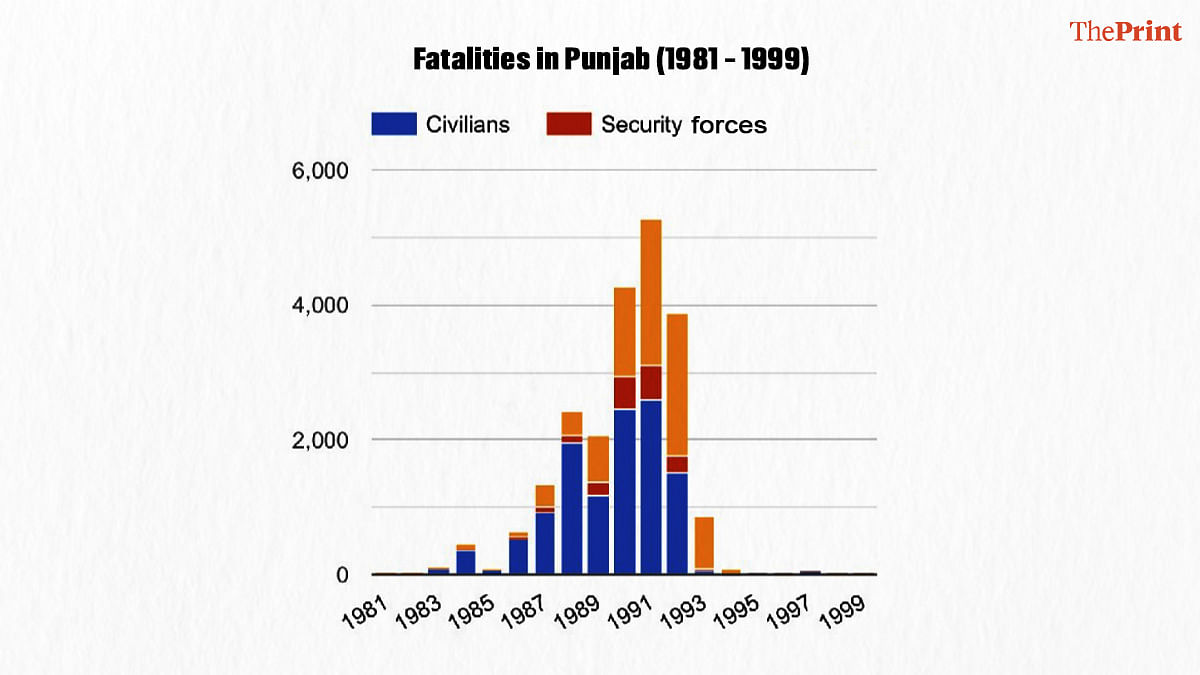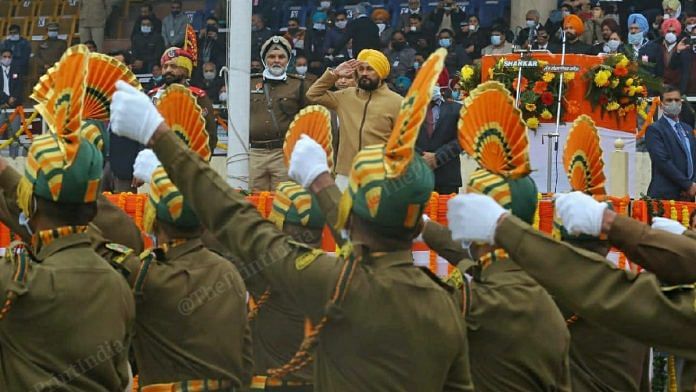For over a year, the media has been agog with the news of the resurgence of the Khalistan movement, which was one of India’s most violent insurgencies. It claimed 21,532 lives — 8,090 separatists, 11,696 civilians and 1,746 security personnel in a span of a decade and a half — 1980 to 1995. All incidents of violence, mass protests, sacrilege and drug-trafficking in Punjab are invariably linked to the likely resurgence of the Khalistan movement by a section of media.
There were reports of Khalistani activists having infiltrated and funded the farmers’ protest against the three farm laws that stand withdrawn today. These allegations were vehemently denied by the Samyukt Kisan Morcha, an umbrella body of different farmer organisations. However, the sporadic violence and hoisting of religious flags on the Red Fort on 26 January certainly proved their presence. Sections of the media and politicians of the Bharatiya Janata Party also alleged that the blocking of Prime Minister Modi’s cavalcade on a flyover in Punjab on 5 January was plotted by the Khalistanis.
In all elections in Punjab since 2007, the resurgence of the Khalistan movement has always been a major issue. Even in the current elections, Capt Amrinder Singh and the BJP coalition has been sparring with the chief minister Charanjit Singh Channi over the issue.
Neither the central nor the state government has given any comprehensive formal report/statement on the current state of the Khalistan movement. Ministry of Home Affairs’ Annual Report 2019-2020 makes no mention of the Khalistan movement except for declaration of the Sikhs for Justice (SFJ) as an “unlawful association” under Unlawful Activities (Prevention) Act 1967. On 1 July 2020, nine well-known Khalistanis were formally designated as terrorists under the UAPA Act as amended in August 2019. Most media analysis is based on “government sources” which can later deny or rely upon the information.
What then is the reality? Are we witnessing a resurgence of Khalistan or is it the runt of the movement fighting for existence and making its presence felt?
Also read: Sikhs no threat to Hindutva but politics has brought back the bogey of Khalistan
Indicators of resurgence
Since August 2019, there have been numerous reports of drones from Pakistan dropping arms, ammunition and IEDs. In 2021, The Tribune reported that the BSF had recovered 34 weapons of all types, including AK series rifles and pistols, 3,322 rounds of ammunition and 485 kg of heroin. In January 2021, Punjab police had recovered an Under Barrel Grenade Launcher, 3.79 kg RDX and a 5kg IED. No official figures are available with respect to the total number of weapons dropped/recovered.
The smuggling of arms and narcotics is certainly an indicator that the ISI and the Khalistani terrorist organisations in Pakistan are attempting to revive the insurgency. However, as per my assessment, the BSF and the Punjab Police have been very efficient and most of the arms/ammunition/IEDs have been recovered with only a trickle reaching the terrorists.
The level of terrorist violence over the last two decades has been very low. As per data based on official sources compiled by Khalistan Extremism Monitor, a project of Institute of Conflict Management since 2000, there have been 38 deaths due to Khalistani terrorist violence. These included 35 civilians and 3 terrorists. No security personnel have been killed in terrorist violence. From 2000 to 2007, there were 21 fatalities, all of civilians. There were no violent incidents between 2008 and 2015. However, from 2016 to date, 14 civilians and three terrorists have been killed. Most of the killings of civilians were targeted attacks on religious or religio-political leaders of RSS and Deras, and other perceived opponents of the Sikh religion. Keeping in view the crime rate, the terrorist violence, so far, has been insignificant. However, data with effect from 2016 does indicate initial attempts to revive the movement.


Beadabi or sacrilege related to the Guru Granth Sahib, the “living guru” of the Sikhs, is a very emotive issue in Punjab. In the past, there has been an intrinsic link between emergence of terrorism and beadabi. The perceived beadabi by head of the Nirankari Sect, Baba Gurcharan Singh, led to the clash between the Akhaand Kirtani Jatha and Damdami Taksal, and the Nirankaris on 13 April 1978, resulting in death of 13 members of the Akhand Kirtani Jatha and emergence of Sant Jarnail Singh Bhindranwale. This, in my view, was the start point of terrorism/Khalistan movement in Punjab. In the 1980s, sacrilege of Gurudwaras and Temples continued to be exploited to spread religious disharmony and fuel terrorism. Sacrilege of Hindu temples in 1982[9] and Nakodar sacrilege case, 1986, are notable examples.
Since the 2015 Bargari sacrilege case, there have been a number of sacrilege cases, with two in quick succession in December 2021. Two unidentified men were lynched, one on the premises of the Golden Temple and another, who later turned out to be a petty thief, at a Gurudwara in Kapurthala. Sacrilege cases can be the handiwork of communalists trying to spread disharmony, politicians trying to garner electoral advantage or mentally deranged persons. Lynchings that go without condemnation coupled with shoddy police investigation only lead to speculation and rumour mongering. Given the past experience, the ISI/Khalistani terrorists have the most to gain from such incidents.
While drug addiction has been common in Punjab, the large–scale smuggling from Pakistan does point towards “narco terrorism” being used as a tool for revival of the Khalistan movement.
The SGPC is dominated by the Akali Dal and virtually acts as its religious arm. For religious/political/electoral reasons, it is party to periodically honouring “martyrs” of the Sikh Quam who in one form or the other were associated with the Khalistan movement. The SGPC constructed a memorial next to Akal Takhat in 2013 for Sant Bhindranwale and other martyrs and recently allowed his photograph to be displayed. Such actions boost the morale of the terrorists.
Also read: Fear of China stealing US’ F-35 wreckage and tech just sensational media speculation
Leaders and organisations
At this juncture, there is no mesmeric leader in the mold of Sant Jarnail Singh Bhindranwale to carry forward the Khalistan movement in Punjab. Only the runt of the overt political/religious organisations, which were active during the Punjab insurgency, remains. All India Sikh Students Federation, once led by Bhindranwale’s nephew, Amrik Singh, is faction ridden and mostly engaged in propagation of Sikh religion. Dal Khalsa, which was the political arm of Bhindranwale, revived itself after its ban expired in 1998. However, it is a mere shadow of its former self with little or no following. Nothing explains the situation better than the state of the Damdami Taksal, once the nursery of religious extremism. Today, it is in cohort with the Bharatiya Janata Party.
The overt organisations driving the Khalistan movement are based in the US, Britain, Canada and Germany. Relative prosperity and open democratic societies pull the Sikh diaspora towards the glorious past of the “Sikh Nation”, reminisced with the notion that Maharaja Ranjit Singh, with only 11 per cent Sikh population, ruled over the territory from Khyber to the Sutlej. Most are not devout Sikhs but are deeply committed to the Sikh identity.
The most prominent Sikh organisation is the US–based Sikhs for Justice, which has promoted “Referendum 2020” for secession of Punjab from the Union of India. The first phase of the referendum was launched in the UK on 31 March 2021, the death anniversary of Indira Gandhi. Gurpatwant Singh Pannun heads the organisation and is known for announcing rewards for those who trigger pro-Khalistan activities and issuing threats. He announced rewards for hoisting the Khalistani flag on Red Fort on 26 January 2021 and preventing PM Modi from visiting Punjab. He regularly issues threats to anyone opposing his ideology or actions. He is also, reportedly, promoting a nexus of Khalistani and Kashmiri terrorists — K2. Canada-based World Sikh Organisation is another prominent outfit with branches in a number of countries. The National Sikh Youth Federation is active in the UK. The Council for Khalistan is based in the US.
These organisations are extremely active on social media and influence the Sikh diaspora and people in Punjab and exploit all incidents related to Sikhs by claiming responsibility. They have no branches or active membership in Punjab. However, they fund the terrorist organisations based in Pakistan and exert political influence in Punjab by covertly funding political parties. Every family in Punjab has one member abroad. The family survives on the money sent back by them and if they are supporters of Khalistan, they indirectly act as influencers.
The runt of terrorist organisations that ran the insurgency in Punjab are now based in Pakistan. Notable among these are Babbar Khalsa International, International Sikh Youth Federation, Khalistan Liberation Force, Khalistan Commando Force and Khalistan Zindabad Force. They have overt members in the US, UK, Germany and Canada. In Punjab, they have only a handful of covert members as is evident from the degree of violence. These organisations also try to influence the pilgrims visiting the gurudwaras in Pakistan.
Also read: Don’t make distinction between India’s fallen heroes. Find a fitting way to pay tribute
Assessment and prognosis
Despite the best efforts of the ISI, terrorist organisations based in Pakistan and pro-Khalistani organisations based in the US, UK, Canada and Germany to revive the Khalistan movement, there are no takers for it in Punjab. However, the vulnerabilities highlighted by me in an earlier article are omnipresent, and it does not take long for the situation to take a turn for the worse.
Punjab Police needs to be revitalised and border security tightened with state of the art technology to counter the emerging threats. The primary vehicle for propaganda is the cyber space, which must be carefully monitored and countered by an ethical counter-programme. The political parties in Punjab need to introspect to manage the finances of the state which has debt of Rs 2.87 lakh crore with a revenue of Rs 70,000 crore per annum, lest the lack of development drives people towards the “Khalistan El Dorado”.
The government must issue a white paper on the state of the Khalistan movement to prevent political exploitation and sensational coverage by sections of the media that label and demonise the entire Sikh community.
Last but not the least, the people of Punjab are carefully watching the ever increasing degree of religious intolerance, violence and discrimination in our nation. Recall, that perceived religious discrimination was one of the main drivers of the Punjab insurgency. A feeling of “next could be us” will be catastrophic for Punjab.
Lt Gen H S Panag PVSM, AVSM (R) served in the Indian Army for 40 years. He was GOC in C Northern Command and Central Command. Post retirement, he was Member of Armed Forces Tribunal. Views are personal.
Edited by Anurag Chaubey



